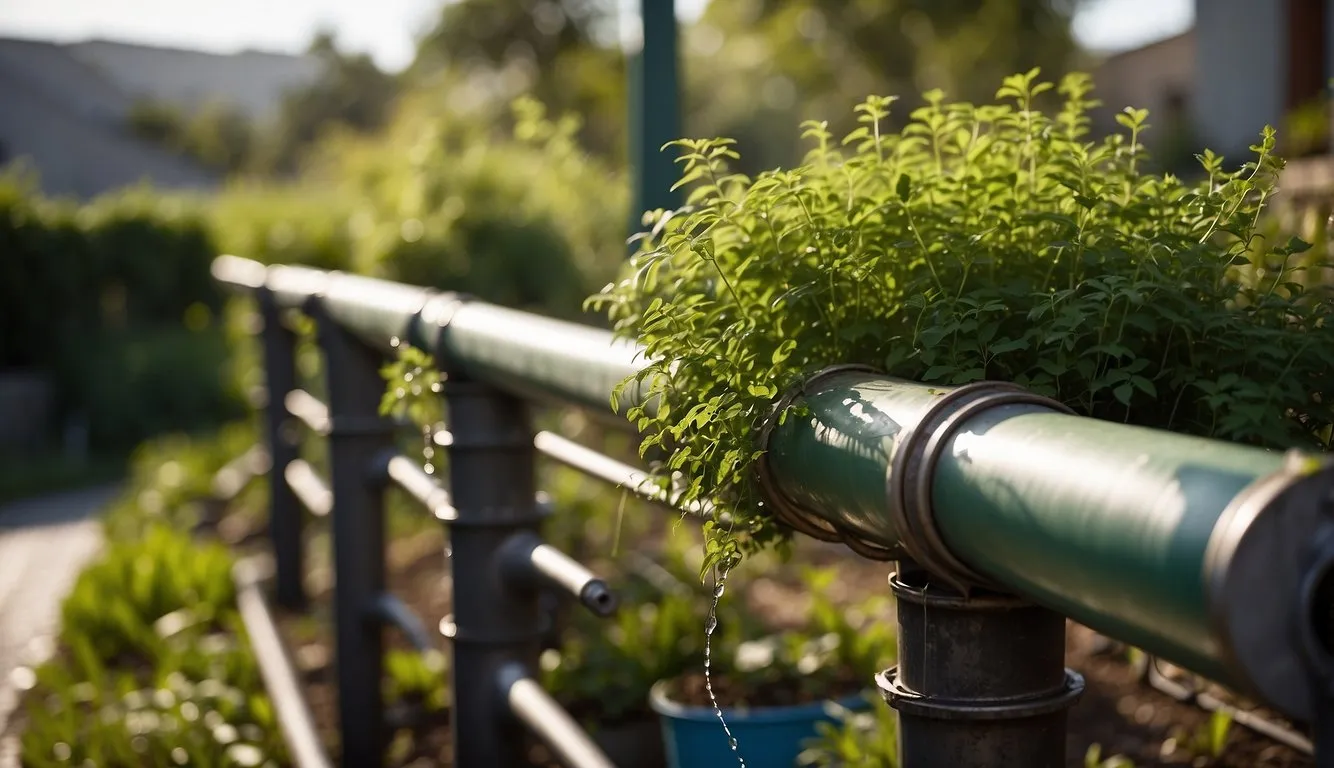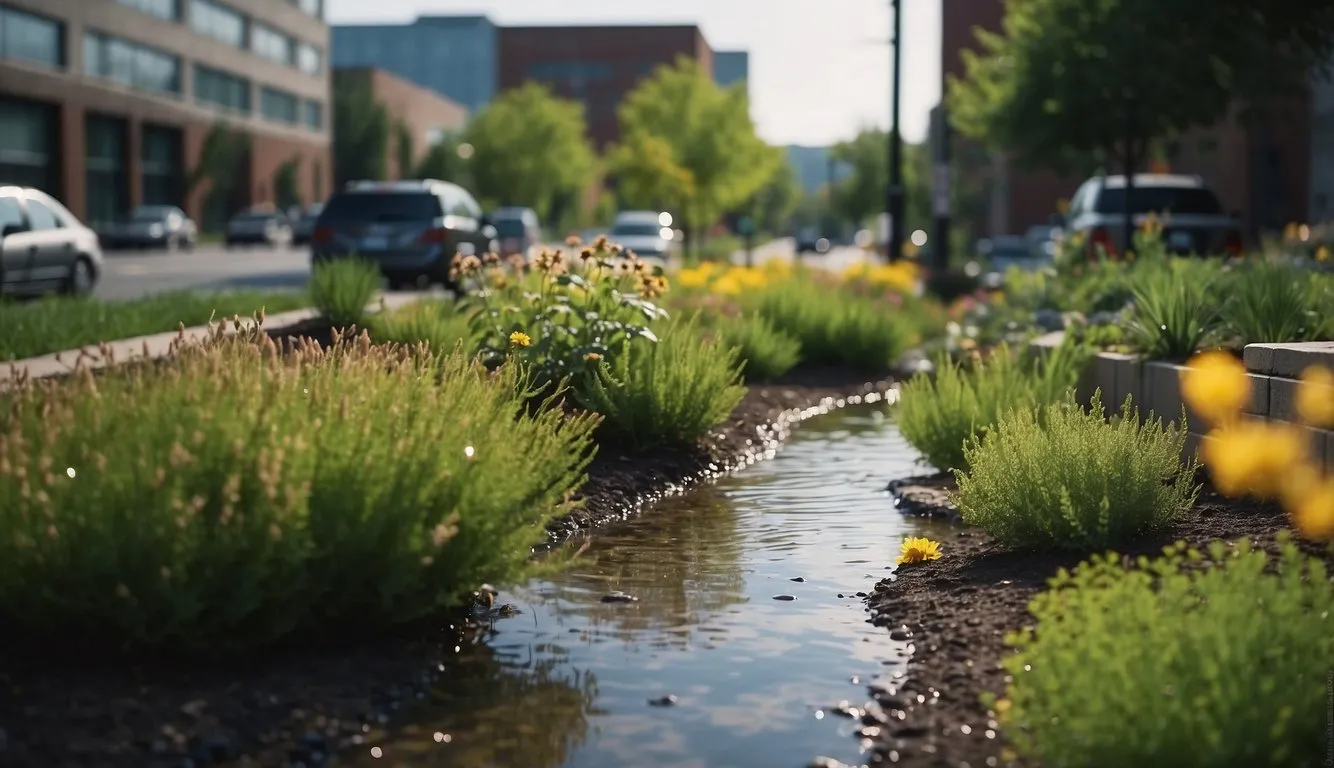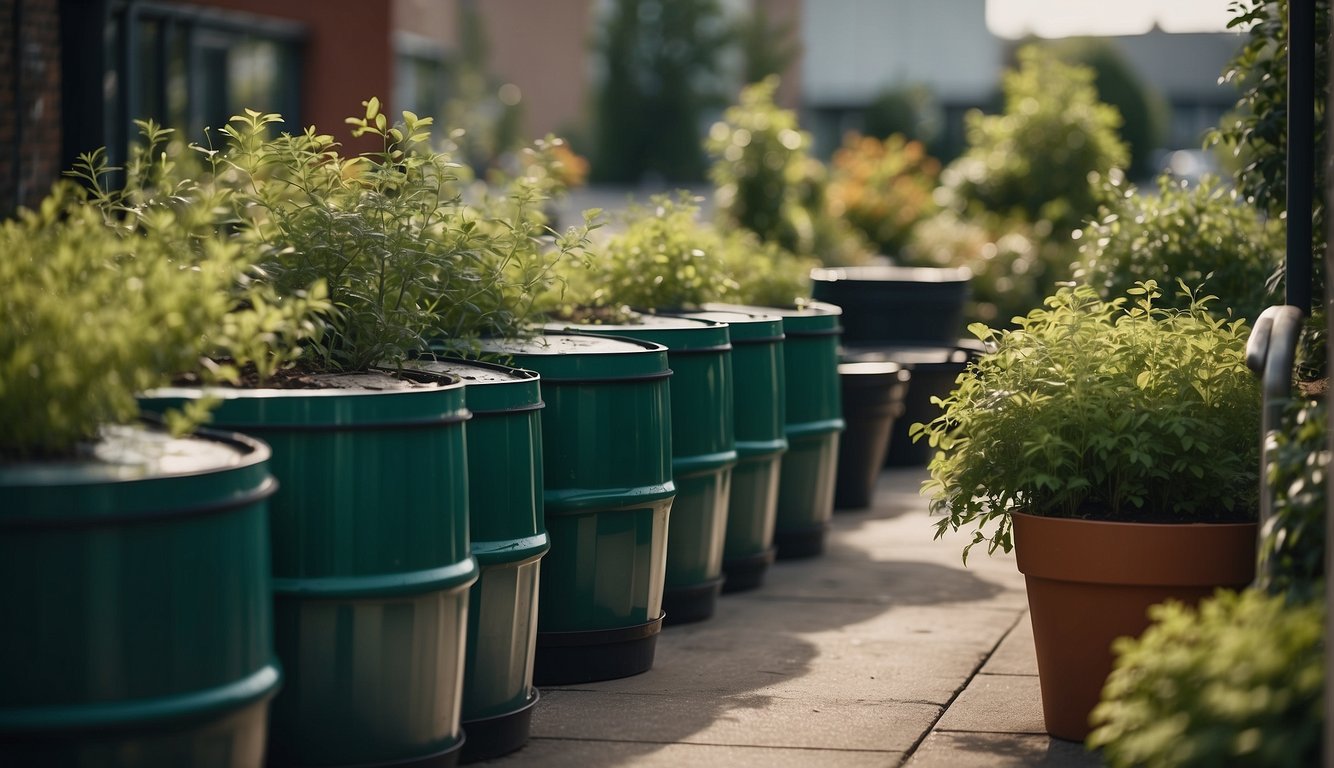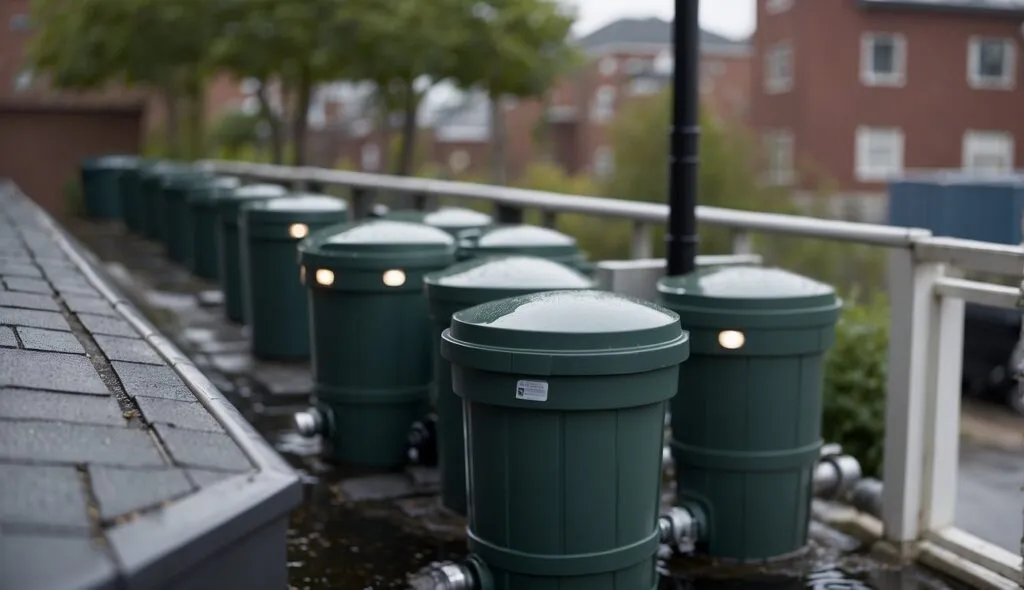As urbanization continues to grow, so does the need for sustainable water management solutions. Urban gardens are becoming increasingly popular as a way to promote green spaces within cities and provide fresh produce to local communities. However, these gardens require a significant amount of water for irrigation, which can put a strain on local water resources. This is where rainwater solutions come in, providing an eco-friendly and cost-effective way to irrigate urban gardens.

Rainwater runoff is a major problem in urban areas, leading to flooding, erosion, and water pollution. By implementing rainwater solutions, we can reduce the amount of runoff and improve water quality. Rain gardens and sustainable landscaping are effective ways to capture rainwater and allow it to infiltrate into the ground, reducing runoff and promoting healthy soil. Rain gardens can also be used to create beautiful and functional green spaces within urban areas.
Rainwater harvesting and storage solutions are another effective way to manage water resources in urban areas. These systems collect rainwater from rooftops and other surfaces, storing it in tanks or cisterns for later use in irrigation. By using rainwater for irrigation, we can reduce our reliance on municipal water systems and conserve water resources. Innovative techniques for urban water management, such as green roofs and permeable pavement, can also help to reduce runoff and improve water quality.
Table of Contents
Key Takeaways
- Urban gardens require a significant amount of water for irrigation, which can put a strain on local water resources.
- Rain gardens and sustainable landscaping can reduce runoff and promote healthy soil.
- Rainwater harvesting and storage solutions can reduce reliance on municipal water systems and conserve water resources.
Understanding Rainwater Runoff and Urban Flooding
As urban areas continue to grow, so does the amount of impermeable surfaces like concrete and asphalt. These surfaces prevent rainwater from being absorbed into the ground, leading to an increase in stormwater runoff. Stormwater runoff is the water that flows over the surface of the ground and into storm drains, streams, and rivers. This runoff can cause urban flooding, which can be costly and dangerous for communities.
Urban flooding occurs when the amount of rainwater exceeds the capacity of the stormwater system. This can happen when rain falls too quickly, or when the system is clogged with debris. Urban flooding can cause damage to buildings, roads, and other infrastructure, as well as pose a risk to human safety.
One solution to the problem of stormwater runoff and urban flooding is to use rainwater harvesting systems. These systems collect rainwater from rooftops and other surfaces, storing it for later use. This reduces the amount of stormwater runoff and can help prevent urban flooding.
Another solution is to use permeable surfaces that allow water to be absorbed into the ground. These surfaces can include permeable pavers, porous concrete, and gravel. By allowing water to be absorbed into the ground, these surfaces reduce the amount of stormwater runoff and can help prevent urban flooding.
In addition to reducing the risk of urban flooding, using rainwater harvesting systems and permeable surfaces can also have environmental benefits. By reducing the amount of stormwater runoff, these solutions can help protect water quality in streams and rivers. They can also help recharge groundwater supplies, which are important sources of drinking water for many communities.
Overall, understanding the problem of stormwater runoff and urban flooding is an important step in finding solutions that work for our communities. By using rainwater harvesting systems and permeable surfaces, we can reduce the risk of urban flooding, protect water quality, and promote sustainable water management practices.
Rain Gardens and Sustainable Landscaping

At the heart of sustainable landscaping is the rain garden. These gardens are designed to capture, filter, and absorb rainwater runoff from roofs, driveways, and other hard surfaces. They are an excellent way to reduce the amount of water that enters storm drains and pollutes our waterways.
Rain gardens also provide many benefits for biodiversity. They provide habitats for birds, butterflies, and beneficial insects. By planting native plants, shrubs, and trees, we can create a green space that supports the local ecosystem. Native plants are also better adapted to local conditions, require less maintenance, and are more resistant to pests and diseases.
When designing a rain garden, it is important to choose the right vegetation. Native plants are ideal because they are adapted to local conditions and require less water than non-native species. They also provide food and habitat for local wildlife. Shrubs and trees are also important because they help to absorb more water and provide shade.
To create a successful rain garden, it is important to choose the right location. The garden should be located in a low-lying area where water naturally collects. It should also be at least 10 feet away from the house to prevent water damage. The size of the garden should be proportional to the size of the roof or hard surface that it is designed to capture runoff from.
In conclusion, rain gardens are an essential part of sustainable landscaping. They provide many benefits for biodiversity, reduce water pollution, and create a beautiful green space. By choosing the right vegetation and location, we can create a rain garden that is both functional and aesthetically pleasing.
Rainwater Harvesting and Storage Solutions
At our urban garden, we understand the importance of water conservation and the need for sustainable water management practices. One of the best ways to achieve this is through rainwater harvesting and storage solutions.
Rainwater harvesting is the practice of collecting and storing rainwater for later use. This can be done through gutters and downspouts that channel rainwater into collection containers such as barrels, cisterns, or water tanks. By doing this, we can reduce our reliance on municipal water sources and help alleviate water scarcity issues.
When it comes to rainwater collection, there are several options available to us. Rain barrels are a popular choice for homeowners due to their affordability and ease of use. These barrels come in various sizes and can be easily connected to downspouts to collect rainwater. However, they have limited storage capacity and are not suitable for larger properties.
For those with larger properties, cisterns and water tanks are a better option. These storage containers can hold a significant amount of rainwater and can be connected to irrigation systems to water plants and gardens. They are more expensive than rain barrels but offer a more long-term solution to rainwater storage.
It’s important to note that rainwater harvesting is not only beneficial for the environment but can also save us money on our water bills. By using rainwater to water our gardens and plants, we can reduce our reliance on municipal water sources and help conserve this precious resource.
In summary, rainwater harvesting and storage solutions are an essential component of sustainable water management practices. Whether through rain barrels, cisterns, or water tanks, collecting and storing rainwater can help us conserve water, save money, and contribute to a more sustainable future.
Pollution Control and Water Quality Improvement
When it comes to urban garden rainwater solutions, pollution control and water quality improvement are key factors to consider. Rainwater runoff can carry pollutants such as sediment, oil, grease, fertilizers, and pesticides, which can contaminate our waterways and harm aquatic life. Therefore, implementing filtration and treatment systems is essential to ensure that rainwater runoff is clean and safe for the environment.
One of the most effective ways to control pollution and improve water quality is by using rain gardens. Rain gardens are shallow depressions that are filled with plants, mulch, and soil, which help to filter and treat rainwater runoff. They are designed to capture and absorb rainwater, which reduces the amount of runoff that enters storm drains and waterways. Rain gardens also help to reduce erosion and sedimentation, which can further improve water quality.
Another effective method for pollution control is the use of filters. Filters can be installed in downspouts, rain barrels, and other rainwater collection systems to remove contaminants such as sediment, debris, and pollutants. Filters come in various types and sizes, including mesh screens, sand filters, and biofilters. By using filters, we can ensure that the rainwater we collect is clean and safe for use in our gardens and landscapes.
In addition to rain gardens and filters, there are other methods for pollution control and water quality improvement. For example, using natural fertilizers and pesticides instead of synthetic ones can help to reduce the amount of pollutants that end up in our waterways. Implementing erosion control measures such as retaining walls, terraces, and vegetative cover can also help to reduce sedimentation and improve water quality.
Overall, pollution control and water quality improvement are essential components of any urban garden rainwater solution. By implementing filtration and treatment systems such as rain gardens and filters, and by using natural fertilizers and pesticides and erosion control measures, we can ensure that rainwater runoff is clean and safe for the environment.
Innovative Techniques for Urban Water Management
As urbanization continues to expand, so does the need for innovative techniques to manage water resources in urban areas. We can no longer rely on traditional methods of stormwater management, such as storm drains, to keep up with the increasing demand for water resources. Instead, we must turn to low impact development and green infrastructure to create sustainable and eco-friendly solutions.
Low Impact Development and Green Infrastructure
Low impact development (LID) and green infrastructure (GI) are two techniques that work together to manage water resources in urban areas. LID uses design techniques to minimize the impact of development on the environment, while GI uses natural systems to manage stormwater runoff. Together, they create a sustainable and efficient system for managing water resources.
One example of LID is permeable surfaces, which allow water to infiltrate into the ground instead of running off into storm drains. This helps to recharge groundwater and reduce surface runoff. Green roofs and bioswales are examples of GI, which use vegetation to absorb and evaporate rainwater runoff. These systems also provide environmental benefits, such as improving air quality and creating habitats for wildlife.
Smart Systems and Eco-Friendly Practices
Smart water systems and eco-friendly practices are another way to manage water resources in urban areas. These systems use technology to monitor and manage water usage, reducing waste and increasing efficiency. For example, smart irrigation systems use weather data to determine when and how much to water plants, reducing water consumption and energy consumption.
Eco-friendly practices, such as rainwater harvesting, also help to reduce the demand for water resources. Rainwater can be collected and used for irrigation, flushing toilets, and other non-potable uses. This reduces the strain on municipal water resources and can also help to recharge groundwater.
In conclusion, innovative techniques for urban water management are essential for creating sustainable and eco-friendly solutions to the increasing demand for water resources in urban areas. By using low impact development, green infrastructure, smart systems, and eco-friendly practices, we can create a resilient and efficient system for managing water resources in urban areas.
Conclusion

In conclusion, we have explored various rainwater solutions for urban gardens. These solutions are not only sustainable but also help in reducing the environmental footprint of urban gardening. By using these solutions, we can conserve water and become more resilient to the changing climate.
Rain gardens are a great way to reduce urban flooding and improve the quality of water. They are easy to install and maintain, and can be customized to fit any garden size. Rain barrels are also a popular option for collecting rainwater. They can be used to water plants and reduce the need for municipal water.
Implementing rainwater solutions in urban gardens is a win-win situation for both the environment and urban gardeners. By conserving water, we are reducing our impact on the environment and saving money on water bills. Additionally, using rainwater to water plants can result in healthier plants and a more bountiful harvest.
As urbanization continues to increase, it is important that we find ways to make our cities more sustainable. Urban gardens are a great way to do this, and by implementing rainwater solutions, we can make them even more sustainable. We encourage all urban gardeners to explore rainwater solutions and help create a more sustainable future.
Frequently Asked Questions
How can rainwater be effectively harvested for urban gardening?
Rainwater can be effectively harvested for urban gardening by collecting it from rooftops, pavements, and other surfaces. The collected water can then be stored in rain barrels or cisterns for later use. A rainwater harvesting system can be installed to divert the collected water to the garden through a series of pipes. By using a rain barrel or cistern, you can reduce your water bill and provide your plants with a natural source of water.
What are the best practices for treating rainwater for garden use?
The best practices for treating rainwater for garden use include using a fine mesh filter to remove debris and sediment, and adding a small amount of chlorine to kill any bacteria or pathogens that may be present. Using a UV sterilizer or ozone generator can also be effective in treating rainwater for garden use. It is important to note that rainwater should not be used for drinking or cooking unless it has been properly treated and tested.
Are there any government programs available that provide free rain barrels?
Yes, there are government programs available that provide free rain barrels to homeowners. These programs are often run by local municipalities or water conservation organizations. Check with your local government or water conservation organization to see if they offer free rain barrels or other incentives for rainwater harvesting.
What design considerations are important for creating a functional rain garden?
When creating a rain garden, it is important to consider the slope of the land, the soil type, and the types of plants that will be used. The garden should be designed to capture and absorb rainwater, allowing it to slowly percolate into the soil. The garden should also be designed to prevent erosion and runoff. A rain garden should be planted with native plants that are adapted to the local climate and soil conditions.
Can rain gardens significantly reduce urban runoff, and how?
Yes, rain gardens can significantly reduce urban runoff by capturing and absorbing rainwater. When rainwater falls on impervious surfaces such as rooftops and pavement, it can quickly run off into storm drains and waterways, carrying pollutants with it. By capturing and absorbing rainwater in a rain garden, the water is allowed to slowly percolate into the soil, filtering out pollutants and reducing the amount of runoff that enters waterways.
What are the benefits of using domestically manufactured rain barrels?
Using domestically manufactured rain barrels can have several benefits, including supporting local businesses, reducing transportation emissions, and ensuring that the barrels meet local regulations and standards. Domestic manufacturers are also more likely to use sustainable and environmentally friendly materials and production methods.


